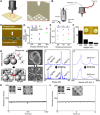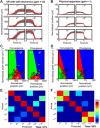Soft, wireless periocular wearable electronics for real-time detection of eye vergence in a virtual reality toward mobile eye therapies
- PMID: 32201718
- PMCID: PMC7069716
- DOI: 10.1126/sciadv.aay1729
Soft, wireless periocular wearable electronics for real-time detection of eye vergence in a virtual reality toward mobile eye therapies
Abstract
Recent advancements in electronic packaging and image processing techniques have opened the possibility for optics-based portable eye tracking approaches, but technical and safety hurdles limit safe implementation toward wearable applications. Here, we introduce a fully wearable, wireless soft electronic system that offers a portable, highly sensitive tracking of eye movements (vergence) via the combination of skin-conformal sensors and a virtual reality system. Advancement of material processing and printing technologies based on aerosol jet printing enables reliable manufacturing of skin-like sensors, while the flexible hybrid circuit based on elastomer and chip integration allows comfortable integration with a user's head. Analytical and computational study of a data classification algorithm provides a highly accurate tool for real-time detection and classification of ocular motions. In vivo demonstration with 14 human subjects captures the potential of the wearable electronics as a portable therapy system, whose minimized form factor facilitates seamless interplay with traditional wearable hardware.
Copyright © 2020 The Authors, some rights reserved; exclusive licensee American Association for the Advancement of Science. No claim to original U.S. Government Works. Distributed under a Creative Commons Attribution NonCommercial License 4.0 (CC BY-NC).
Figures






Similar articles
-
Skin-conformal, soft material-enabled bioelectronic system with minimized motion artifacts for reliable health and performance monitoring of athletes.Biosens Bioelectron. 2020 Mar 1;151:111981. doi: 10.1016/j.bios.2019.111981. Epub 2019 Dec 23. Biosens Bioelectron. 2020. PMID: 31999588
-
Stretchable Nanocomposite Sensors, Nanomembrane Interconnectors, and Wireless Electronics toward Feedback-Loop Control of a Soft Earthworm Robot.ACS Appl Mater Interfaces. 2020 Sep 30;12(39):43388-43397. doi: 10.1021/acsami.0c10672. Epub 2020 Aug 28. ACS Appl Mater Interfaces. 2020. PMID: 32791828
-
Soft Material-Enabled, Active Wireless, Thin-Film Bioelectronics for Quantitative Diagnostics of Cervical Dystonia.Adv Mater Technol. 2019 Oct;4(10):1900458. doi: 10.1002/admt.201900458. Epub 2019 Aug 16. Adv Mater Technol. 2019. PMID: 33043125 Free PMC article.
-
Recent advances in wearable biosensing gloves and sensory feedback biosystems for enhancing rehabilitation, prostheses, healthcare, and virtual reality.Biosens Bioelectron. 2021 Oct 15;190:113443. doi: 10.1016/j.bios.2021.113443. Epub 2021 Jun 17. Biosens Bioelectron. 2021. PMID: 34171820 Review.
-
Stretchable, Skin-Attachable Electronics with Integrated Energy Storage Devices for Biosignal Monitoring.Acc Chem Res. 2019 Jan 15;52(1):91-99. doi: 10.1021/acs.accounts.8b00508. Epub 2018 Dec 26. Acc Chem Res. 2019. PMID: 30586283 Review.
Cited by
-
A Hierarchical Theory for the Tensile Stiffness of Non-Buckling Fractal-Inspired Interconnects.Nanomaterials (Basel). 2023 Sep 11;13(18):2542. doi: 10.3390/nano13182542. Nanomaterials (Basel). 2023. PMID: 37764571 Free PMC article.
-
Eye tracking and eye expression decoding based on transparent, flexible and ultra-persistent electrostatic interface.Nat Commun. 2023 Jun 7;14(1):3315. doi: 10.1038/s41467-023-39068-2. Nat Commun. 2023. PMID: 37286541 Free PMC article.
-
The application of metaverse in mental health.Front Public Health. 2025 Apr 10;13:1463494. doi: 10.3389/fpubh.2025.1463494. eCollection 2025. Front Public Health. 2025. PMID: 40276352 Free PMC article. Review.
-
Advances in Soft and Dry Electrodes for Wearable Health Monitoring Devices.Micromachines (Basel). 2022 Apr 16;13(4):629. doi: 10.3390/mi13040629. Micromachines (Basel). 2022. PMID: 35457934 Free PMC article. Review.
-
Highly Robust and Wearable Facial Expression Recognition via Deep-Learning-Assisted, Soft Epidermal Electronics.Research (Wash D C). 2021 Jul 15;2021:9759601. doi: 10.34133/2021/9759601. eCollection 2021. Research (Wash D C). 2021. PMID: 34368767 Free PMC article.
References
-
- Govindan M., Mohney B. G., Diehl N. N., Burke J. P., Incidence and types of childhood exotropia: A population-based study. Ophthalmology 112, 104–108 (2005). - PubMed
-
- Baek J.-Y., An J.-H., Choi J.-M., Park K.-S., Lee S.-H., Flexible polymeric dry electrodes for the long-term monitoring of ECG. Sens. Actuators A Phys. 143, 423–429 (2008).
-
- Donnelly U. M., Stewart N. M., Hollinger M., Prevalence and outcomes of childhood visual disorders. Ophthalmic Epidemiol. 12, 243–250 (2005). - PubMed
Publication types
MeSH terms
LinkOut - more resources
Full Text Sources
Medical

